National Depression Glass Association
Preserving America's Glass Manufacturing Heritage
Jeanette's Cherry Blossom - Part I
by Rosemary Trietsch
The longer I live, the more strongly I believe that our lives are not random, that there is some force guiding our destinies, and that if something is meant to happen, it will. This month's article is proof. Back in February, I was talking with someone about possible subjects for my next column. He suggested that Cherry Blossom would be in keeping with the season, as it would be published just as spring begins. I quickly said, "No, I can't write about Cherry Blossom. I haven't handled nearly enough of it to know the real from the fake." One week later, someone called with a collection of pink Cherry Blossom for sale.
Now this did strike me as some coincidence, but I didn't feel
I could do justice to a Cherry Blossom article. Three days after
the 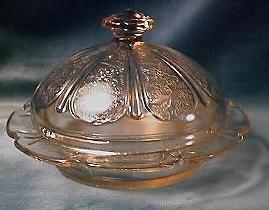 first
bunch arrived, I got another call from someone else who had some
glass for sale. This time it was green Cherry Blossom. Still, I
resisted. The day the green set arrived, I got another call. This
time, the set (you KNOW what pattern it was) included delphite,
children's pieces, and even a box of reproduction pieces. Four
weeks and 318 pieces of Cherry Blossom later, my fate was sealed.
And so I write this month's column surrounded by Cherry Blossom
in it's many shapes and colors. I feel like I'm inside a prism
that's catching the sunlight and making rainbows all around. All
in all, not a bad place to be ...
first
bunch arrived, I got another call from someone else who had some
glass for sale. This time it was green Cherry Blossom. Still, I
resisted. The day the green set arrived, I got another call. This
time, the set (you KNOW what pattern it was) included delphite,
children's pieces, and even a box of reproduction pieces. Four
weeks and 318 pieces of Cherry Blossom later, my fate was sealed.
And so I write this month's column surrounded by Cherry Blossom
in it's many shapes and colors. I feel like I'm inside a prism
that's catching the sunlight and making rainbows all around. All
in all, not a bad place to be ...
Cherry Blossom was made by the Jeannette Glass Company from
1930 to 1939. It was primarily produced in pink and green, with
Delphite added 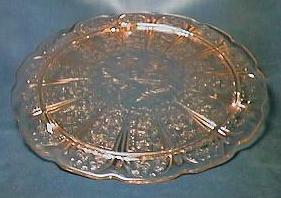 in 1936. Additionally, a few pieces have been found in jadite,
crystal, red, yellow, and orange slag. There have even been some
amber child's pieces found. These odd color pieces are probably
the result of having a bit of leftover glass at the end of the
day. Rather than waste it, the workers used it to produce a
limited run of something or other. If there were enough of them,
these pieces could be used as premiums or to fill promotional
orders the company might get. More often than not, however, the
workers took them home and used them. This is also true of
experimental pieces that never went into full production, and
explains why rare items in Depression glass are almost always
discovered within walking distance of the factory.
in 1936. Additionally, a few pieces have been found in jadite,
crystal, red, yellow, and orange slag. There have even been some
amber child's pieces found. These odd color pieces are probably
the result of having a bit of leftover glass at the end of the
day. Rather than waste it, the workers used it to produce a
limited run of something or other. If there were enough of them,
these pieces could be used as premiums or to fill promotional
orders the company might get. More often than not, however, the
workers took them home and used them. This is also true of
experimental pieces that never went into full production, and
explains why rare items in Depression glass are almost always
discovered within walking distance of the factory.
Cherry Blossom has more than its share of these experimental
and hard to find pieces. While the 10½ inch round tray is
relatively 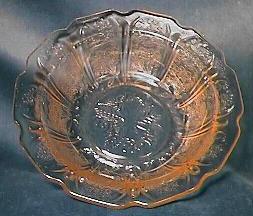 easy
to find, this same tray has turned up as a 5 part divided relish
(4 compartments around a circular center). Weatherman documented
the first one found in 1976 and said that it was "obtained
originally from and ex-employee of Jeanette, who said the dish
was an experiment." A pink cookie jar with a high domed lid was
first discovered in 1978, but has proved scarce enough to not be
included in the general price lists. The most famous (or perhaps
infamous is a better word) of the Cherry Blossom rarities is the
salt and pepper shaker set. Only 2 pairs of pink shakers and
approximately 12 green sets have been found and verified as
originals.
easy
to find, this same tray has turned up as a 5 part divided relish
(4 compartments around a circular center). Weatherman documented
the first one found in 1976 and said that it was "obtained
originally from and ex-employee of Jeanette, who said the dish
was an experiment." A pink cookie jar with a high domed lid was
first discovered in 1978, but has proved scarce enough to not be
included in the general price lists. The most famous (or perhaps
infamous is a better word) of the Cherry Blossom rarities is the
salt and pepper shaker set. Only 2 pairs of pink shakers and
approximately 12 green sets have been found and verified as
originals.
The 6¾ inch pitcher, 9 inch grill plate, and 3 footed
fruit bowl have all been found in jadite. These pieces date to
1932 when 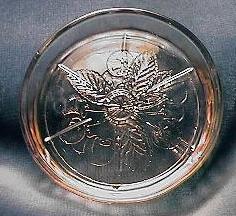 Jeanette first introduced that color for their kitchenware lines.
The large berry bowl has been found in yellow and an orange slag
with green trim. The problem with using opaque glass for Cherry
Blossom pieces is that the pattern doesn't show unless you turn
the plate or bowl over. Collectors of Delphite Cherry Blossom are
all too familiar with this problem. Still, there's enough
Delphite pieces available to make a basic service and as the
pattern is on the outside of many of them, it's lovely on the
table.
Jeanette first introduced that color for their kitchenware lines.
The large berry bowl has been found in yellow and an orange slag
with green trim. The problem with using opaque glass for Cherry
Blossom pieces is that the pattern doesn't show unless you turn
the plate or bowl over. Collectors of Delphite Cherry Blossom are
all too familiar with this problem. Still, there's enough
Delphite pieces available to make a basic service and as the
pattern is on the outside of many of them, it's lovely on the
table.
A 9-inch oval platter lurks among the hard to find pieces of
Cherry Blossom. This platter measures 9 inches from outside edge
to outside edge. Don't confuse it with the 11-inch platter, which
measures 9 inches from the inside rim or you'll end up paying
about $900 too much for a relatively easy to find piece. (IS
there such a thing as an 'easy to find piece'?) Mugs in perfect
condition are also a challenge to find as most of them have a
crack where the handle meets the side. This is probably the
result of poor mold design, but is definitely a pain in the neck
for collectors. Flat iced tea tumblers, soup and cereal bowls,
and 10-inch grill plates round out the "Pieces Most Likely to be
Missing from Your Collection" list. Large serving pieces aren't
easy to 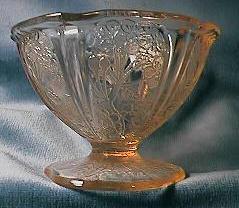 come up with
either, but as most people only need one or two platters -- as
opposed to 12 tumblers or bowls --you will find them around. They
don't come cheap, though.
come up with
either, but as most people only need one or two platters -- as
opposed to 12 tumblers or bowls --you will find them around. They
don't come cheap, though.
When it comes to Cherry Blossom, confusion is the norm. During the nine years it was produced, worn molds were replaced with others that varied from the originals. The foot was originally round on the tumblers, sherbet, and 6¾ inch pitcher. Later molds were made with a scalloped or indented foot that echoes the rim of the bowls and plates. This is not a sure way to date your footed pieces, though, as not all of the molds were replaced so both round and scallop footed pieces were produced at the same time. In addition, the 4½ inch footed tumbler with the round foot holds 9 oz, while the scallop footed tumbler of the same height only holds 8 oz. Another variation on the foot comes with the pattern impressed in the bottom. Some pieces have 3 clusters of cherries arranged in a sort of pinwheel design. Others have a horizontal branch with cherries and leaves. I have in front of me 4 sherbets: 1 scalloped and 1 round foot with the branch design, and 1 scalloped and 1 round with the pinwheel cherry design. (Incidentally, each of the three collections I bought had both style sherbets mixed together.)
If you order your Cherry Blossom through the mail or Internet,
you'll have to specify your preference for round or scalloped
foot. In 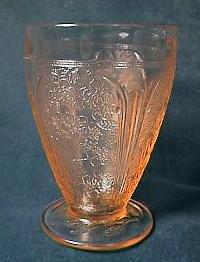 addition, you'll have to decipher a few abbreviations that you
always find in Cherry Blossom listings. AOP means "All Over
Pattern" and refers to the footed tumblers and 6¾ inch
pitcher. PAT means "Pattern At the Top" and refers to the flat
tumblers and pitcher, and also to the 8 inch footed pitcher.
Lastly, IRR, which stands for "Inner Rim Roughness", is an
abbreviation that applies to many Depression glass patterns.
Cherry Blossom bowls and platters have a rim around the edge and
the inner part of this rim does suffer as a result of years of
being stacked and restacked from use. When you're checking the
condition of pieces of Cherry Blossom, don't forget this inner
edge. If a little wear bothers you, Cherry Blossom will drive you
crazy.
addition, you'll have to decipher a few abbreviations that you
always find in Cherry Blossom listings. AOP means "All Over
Pattern" and refers to the footed tumblers and 6¾ inch
pitcher. PAT means "Pattern At the Top" and refers to the flat
tumblers and pitcher, and also to the 8 inch footed pitcher.
Lastly, IRR, which stands for "Inner Rim Roughness", is an
abbreviation that applies to many Depression glass patterns.
Cherry Blossom bowls and platters have a rim around the edge and
the inner part of this rim does suffer as a result of years of
being stacked and restacked from use. When you're checking the
condition of pieces of Cherry Blossom, don't forget this inner
edge. If a little wear bothers you, Cherry Blossom will drive you
crazy.
Cherry Blossom remains one of the most popular and heavily collected Depression glass patterns of all time. Its popularity however, has also caused it to be the most reproduced Depression glass pattern of all time. Importers looking to capitalize on Cherry Blossom's popularity have brought in fake shakers, butter dishes and children's pieces, just to name a few pieces from the list. (Of course they reproduced the expensive and desirable pieces first. After all, why counterfeit a $1.00 bill when you can make a $100.00?) Can you tell the original from the fake? Next month, we'll continue our look at Cherry Blossom and I'll help you figure out what "off set mould lines", "canal type leaves", and "leaves and cherries east/west from north/south handles" mean in plain English.
Sources:
- Florence, Collector's Encyclopedia of Depression Glass, 13th edition
- Weatherman, 76 Price Trends